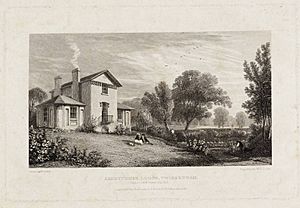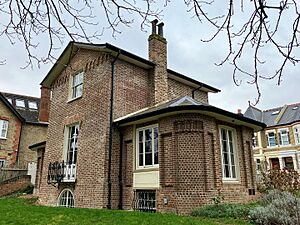Sandycombe Lodge facts for kids
Quick facts for kids Sandycombe Lodge |
|
|---|---|
| Solus Lodge | |

Sandycombe Lodge in 1814
|
|
| Location | 40 Sandycoombe Road, Twickenham TW1 2LR, London Borough of Richmond upon Thames |
| Built | 1813 |
| Built for | J. M. W. Turner and his father William Turner |
| Architect | J. M. W. Turner |
| Architectural style(s) | Picturesque-cottage style |
| Governing body | Turner's House Trust |
|
Listed Building – Grade II*
|
|
| Official name: Sandycombe Lodge | |
| Designated | 2 September 1952 |
| Reference no. | 1262429 |
Sandycombe Lodge is a special house in Twickenham, London. It's called a Grade II* listed building, which means it's very important historically. The famous artist J. M. W. Turner designed and built this house in 1813. He used it as a quiet country home for himself and his father, William. Turner lived here from 1814 to 1826.
The house was originally known as Solus Lodge. It is the only building that Turner himself designed and is still standing today. Its style, called "picturesque-cottage," was influenced by his friend Sir John Soane. Over the years, the house changed quite a bit. For example, second floors were added to its original side wings.
A Country Retreat
When Sandycombe Lodge was built, the area around Twickenham was mostly countryside. It was a peaceful place, very different from the busy city of London. You can see how rural it was in an old picture from 1814. This picture is an engraving called Sandycombe Lodge, Twickenham, Villa of J. M. W. Turner. It was made by W. B. Cooke after William Havell's work. Today, this engraving is kept at Tate Britain museum.
The House Through Time
After Turner sold Sandycombe Lodge in 1826, it had many different owners. During the Second World War, the house was even used as a factory. Workers made uniforms for airmen there. The heavy machines caused damage to the house's staircase and ceilings.
In 1947, Professor Harold Livermore and his wife Ann bought the house. They cared deeply about its history. In 2005, they created the Sandycombe Lodge Trust. This trust is now known as Turner's House Trust. After Professor Livermore passed away in 2010, he left the house to the Trust. His wish was for it to be kept safe as a monument to Turner.
Bringing History Back to Life
Many of the house's original features were still there, but it needed a lot of work. The Turner's House Trust wanted to raise money to fix the house. Their goal was to remove changes made in Victorian times and make it look like it did when Turner lived there.
In January 2015, the Trust received a big grant of £1.4 million. This money came from the Heritage Lottery Fund. It helped them start the restoration work. The renovation cost £2.4 million in total and took about a year, starting in March 2016.
Today, the restoration of Turner's House is complete. The house is open to visitors. You can explore it and imagine how Turner lived there. You can also learn about the amazing effort to save this important historic home.
See also
- View of Richmond Hill and Bridge, an 1808 Turner painting of nearby Richmond Bridge


